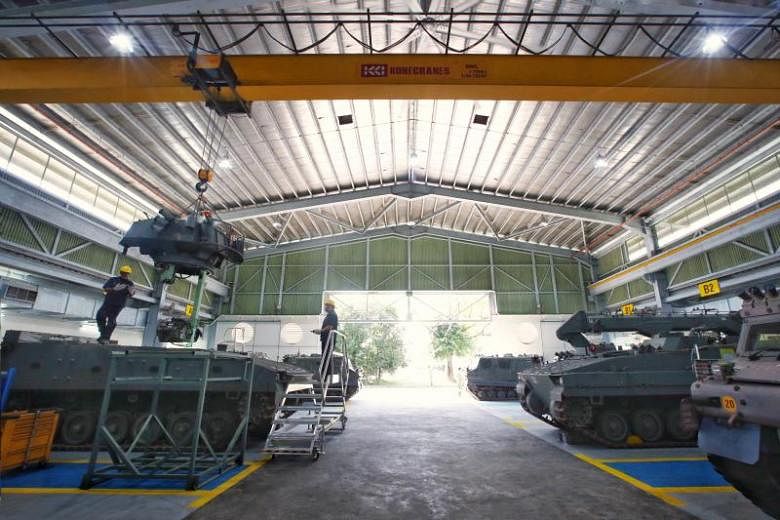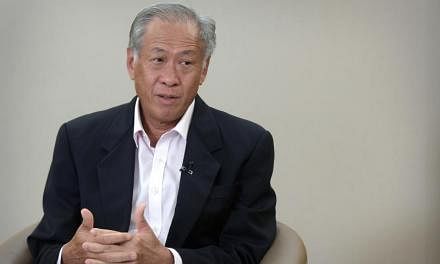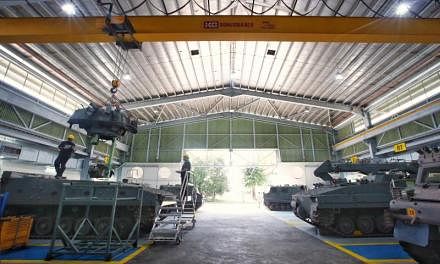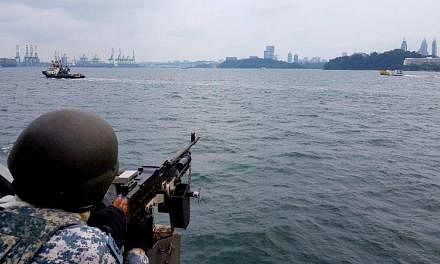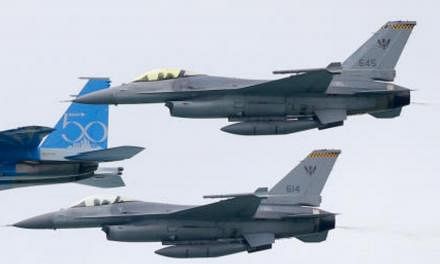The Singapore Armed Forces is leveraging technology to help soldiers train and operate better. The Straits Times looks at some of the new initiatives.
1. Hub takes less time to maintain, repair tracked vehicles
A new hub for tracked vehicles in Sungei Gedong to perform depot-level maintenance tasks in an army camp has reduced manpower costs by 20 per cent .
Time needed for repairs has also been cut by 50 per cent, reducing turn-around time for vehicles such as the Bionix Infantry Fighting Vehicles and Bronco All-Terrain Tracked Carriers.
This means that such vehicles will be more readily available for training and operations, by allowing staff from a contractor to work in camp, rather than having to send the vehicles to their depot - taking a longer time and costing more.
The SAF's first Integrated Forward Maintenance Hub at Sungei Gedong Camp launched in March this year (2018).
The next integrated hub at Kranji Camp, meant for the army's motorised infantry fleet of vehicles, will open next year.
Having ST Engineering Land Systems technicians at an army camp means certain work processes can be simplified.
For example, a minor welding job could have taken six days in the past - three days to prepare the paperwork and logistics to get the vehicle transported to ST Engineering Land Systems at Jalan Boon Lay Depot and back.
Now, this task can be done in Sungei Gedong in one day.
On average, depot-level work used to take 24 days, but now take 12 days with the co-location of facilities in Sungei Gedong.
Other than a workshop, the hub at Sungei Gedong also has a warehouse that stores commonly-used spare parts, which were previously stored at the Army Logistics Base at Old Choa Chu Kang Road.
A new Independent Spares Retrieval and Exchange System (iSpares) at the warehouse, similar to SingPost's POPstation, also means that technicians can now collect required spare parts from self-locking storage boxes at their convenience.
This takes away the need to meet the person in charge of the store.
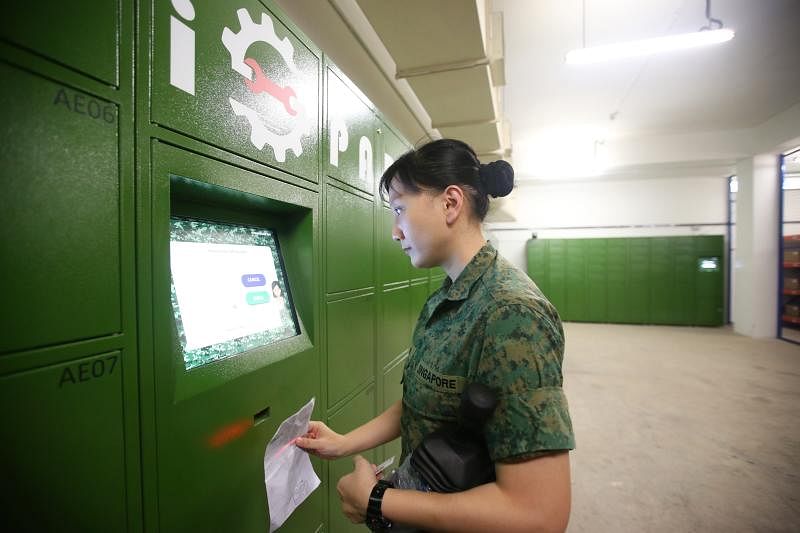
There is also an office at the hub that helps to reduce administrative processing time for handling quotations and warranty claims.
Chief maintenance and engineering officer, Military Expert 7 Tan Mu Yen, said: "What we've attempted to do with the hub is to organise all the relevant maintenance support functions, redesign our work flow, to basically cut down unnecessary admin downtime, and handing and taking over between individuals."
Another initiative by the army's Maintenance and Engineering Support formation is a system that gathers data to allow a more optimal maintenance regime to be designed.
Using a data analytics engine, information collected about a tracked vehicle, such as its movement, fuel use, and engine speed, can be analysed to predict when maintenance needs to be carried out.
This is as compared to servicing the vehicles according to certain rules, such as after having travelled a certain distance, which may not be optimal.
The Telemetry and Analytics System (TAS) has already been implemented for the army's fleet of unmanned aerial vehicles (UAV), cutting technical investigation time from 48 hours to eight hours per UAV.
Military Expert 4 Wilgene Tan, who worked on the algorithm behind the TAS, said: "Once we're able to decipher this data, our main aim is to predict failure of the vehicles, to stretch the maintenance dollar and hopefully, save the army money."
2. Parachute flight simulator boosts landing accuracy
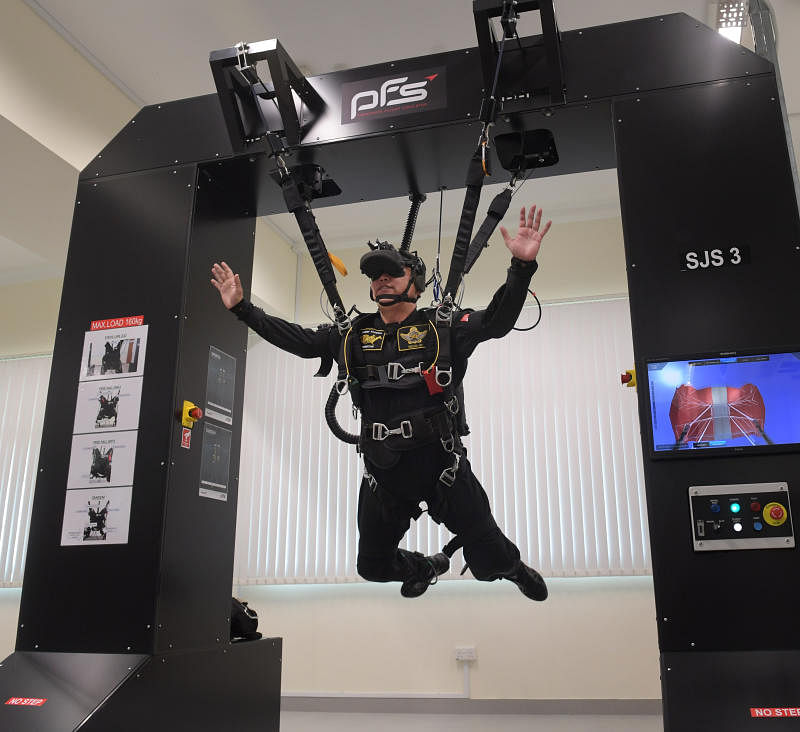
Before a commando makes his first live parachute jump, he can now practise controlling his parachute to land accurately without having to go on a plane.
The Parachute Flight Simulator in Pasir Ris Camp has reduced the number of trainees who land out of the designated landing zones from a few cases each year to zero.
The facility opened in 2014 to help trainees with static line parachuting. Since mid-2017, it has also provided training to those doing freefall courses.
There are six such simulators at Pasir Ris Camp, which are able to replicate a range of environments and weather conditions, such as rain and wind.
The trainee is strapped up across his body and wears a display mounted on his head.
Pulling on the attached straps will simulate a reaction mirroring that of a live descent.
A video of how the trainee performed and his flight path can be recorded and replayed to point out areas for improvement.
One of the key benefits of using the simulator is in improving canopy control, said Major Arnold Low, commanding officer of the the Special Operations Tactical Support Centre (SOTSC), which operates the facility.
He said: "The flight simulator enhances our training, putting our trainees in an environment where they can see the actual conditions they can expect to see during the live task."
Other benefits include being able to test a trainee's reaction to emergency scenarios, such as when the parachute is torn or fails to deploy properly.
The simulators are also used by the Red Lions parachute display team to rehearse their descents onto the floating platform at Marina Bay.
Static Line Detachment Commander and airborne instructor, First Warrant Officer Ng Chin Hun, said that after the implementation of the simulator training, he no longer has trainees landing out of the drop zone during their live jumps.
"This is because after going through the simulator, their canopy control is now much better... From the simulator itself, we can see what exactly the airbase looks like for trainees to familiarise themselves, be it at Sembawang or Paya Lebar Airbase," he said.
3. Augmented reality glasses helps air force trainees reduce errors
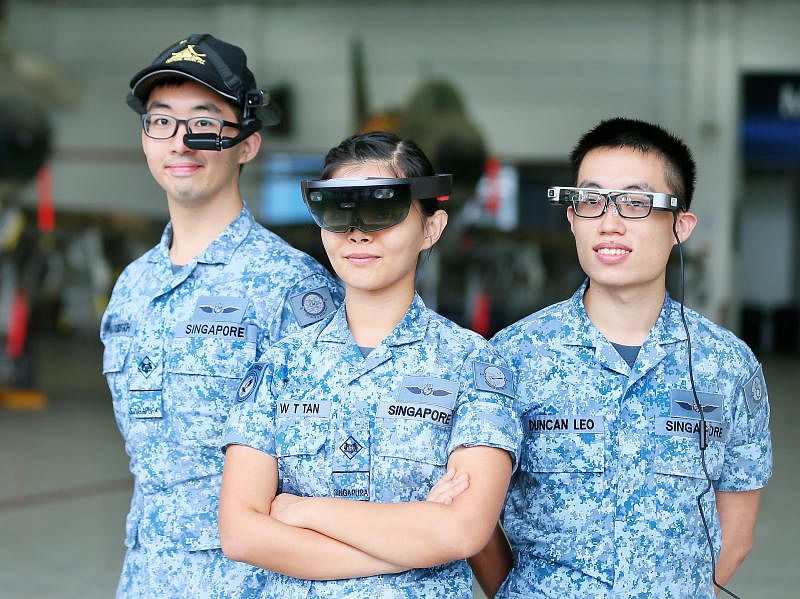
The Republic of Singapore Air Force has begun experimenting with the use of augmented reality training aids, such as a lens that uses holograms to simulate environments, to improve training realism and effectiveness.
The mixed reality lens allows for scenarios that are difficult to replicate in real life, enhancing experiential learning.
These scenarios include aircraft emergency response, or when a ground power generator catches fire.
A trainee would have to react on the spot and perform remedial actions, by interacting with the holograms using hand gestures.
This has been on trial since earlier this year (2018). The air force plans to implement it for training at the Air Engineering Training Institute from July.
Another gadget, a head-mounted micro tablet that is operated using voice commands, allows users to retrieve information easily, without having to use their hands or refer to hardcopy manuals.
The device also supports remote mentoring, where an instructor can look at what the trainee sees when he is working and offer advice.
While the mixed reality lens and micro tablets have been on trial this year, smart glasses have already been in use since last year.
It offers similar functions to the micro tablet in allowing an instructor to see what a trainee sees via live video streaming, but is less obtrusive.
This is useful when doing work in confined spaces, such as under a fighter jet.
ME6 Ken Chua, commander of the Air Engineering Training Institute, said: "(One) benefit of using such technology is that you can inject scenarios that you can't replicate in real life. In this manner, we're actually expanding the training envelope."
"Such scenarios simulated allow trainees to gain confidence before they do the live training."
Air force engineer Geraldine Tan, 20, who used the mixed reality lens for her training, said: "Traditionally, the instructor will be standing beside you and asking you to read through the steps and procedures first. Afterwards, you bring the paper to the real asset and do the checks one by one."
"But this can be quite scary because we're learning it for the first time. Moreover, not many people can try it because the assets are limited."
In the past, only a minority out of a group of trainees could practise on a real system.
"But with the lens, everyone can try it and familiarise themselves with the system," added ME1 Tan.
